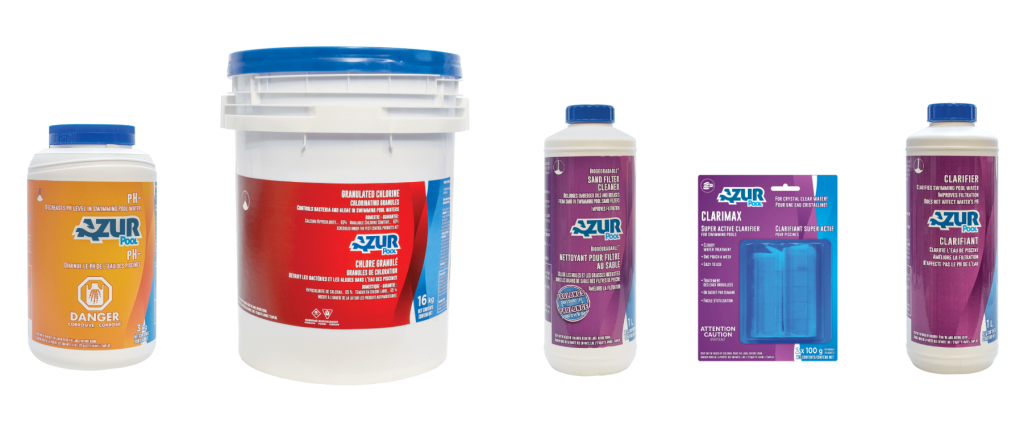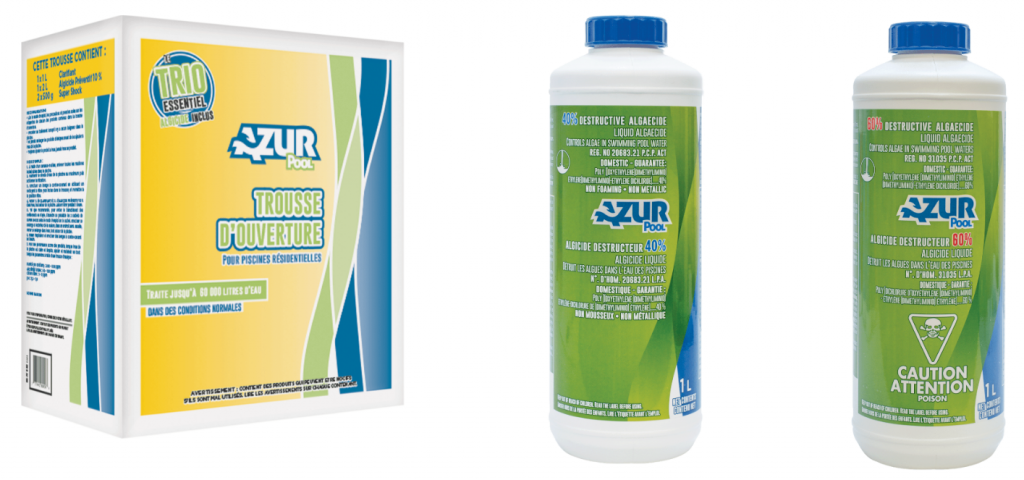FAQ
FREQUENTLY ASKED QUESTIONS
FIND ALL THE ANSWERS TO YOUR QUESTIONS WITH OUR AZUR FAQ.
WHAT CHEMICALS SHOULD BE USED WHEN STARTING UP A POOL AT THE BEGINNING OF THE SEASON?
A OPENING KIT is the easiest and most effective way to start up your pool at the beginning of the season. However, if your pool water is black or dark green, with a lot of leaves accumulated at the bottom, the addition of a 40% OR 60% DESTRUCTIVE ALGAECIDE is recommended.
WHAT IS THE BEST TIME OF DAY TO ADD CHLORINE?
It is recommended that chlorine be added at the end of the day once the sun has set and there are no more bathers in the pool.
HOW DO I MAINTAIN A PROPER PH LEVEL?
If the pH of your pool is always too high, it’s probably because you are using chlorine with a high pH level (granulated chlorine). Adjust the pH by adding pH- to keep the pH level between 7.2 and 7.8.
If the pH of your pool is always too low, it’s probably because you are using chlorine with a low pH level (stabilized chlorinating pucks). Adjust the pH by adding pH+ to keep the pH level between 7.2 and 7.8.
If the pH fluctuates up or down and it is difficult to keep it between 7.2 and 7.8, make sure you check the alkalinity level of the pool water and keep it between 80 and 120 ppm.
WHAT DO I HAVE TO DO IF ALGAE GROW IN MY POOL WATER?
If algae start to grow, then your pool water quite likely lacked chlorine. To get rid of algae effectively, add TURBO SHOCK and DESTRUCTIVE ALGAECIDE.
Wait three hours and then brush the walls and the bottom of the pool. Wait 12 hours and vacuum to pick up the dead algae from the bottom of the pool. Then do a backwash.
Note: A slippery pool liner is a sign that algae are beginning to grow.
MY POOL WATER SEEMS CLOUDY. HOW CAN I RESOLVE THIS PROBLEM?
Cloudy water can be caused by various improperly adjusted parameters. Check the following points:
- If the pH of your pool water is too high (above 7.8), lower it with pH-.
- If the free CHLORINE level of your pool water is lower than 1 ppm, raise it to a maximum of 3 ppm.
- If the sand in your pool filter hasn’t been cleaned in the last year, clean it with a SAND FILTER CLEANER.
- If all of the above parameters are properly adjusted, add CLARIFIER (STICKS OR LIQUID).

HOW OFTEN DO I HAVE TO CLEAN THE SAND IN MY POOL FILTER AND WHY?
The sand in the filter should be cleaned once a year, at the beginning of the season or at the end of the season. Cleaning is done with a SAND FILTER CLEANER.
Using this product will extend the life of the sand in your filter and avoid potential filtration problems with your pool.
IS IT TRUE THAT THE SUN’S ULTRAVIOLET RAYS ELIMINATE THE CHLORINE IN MY POOL AND IF SO, HOW CAN I RESOLVE THE PROBLEM?
The sun’s ultraviolet rays do in fact eliminate the free chlorine in your pool water on hot sunny days.
The addition of STABILIZER will help prevent the sun’s ultraviolet rays from destroying the free chlorine in your pool water.
It is important to keep the stabilizer level between 30 and 50 ppm.
This product must be used only when granulated chlorine is used (calcium hypochlorite) or in pools with a salt chlorinator.
WHY DO MY EYES BURN WHEN I OPEN THEM UNDER WATER?
Contrary to popular belief, a high chlorine level will not irritate the eyes. Only two factors are responsible for these irritations:
- The presence of chloramines (combined chlorine)
- An improperly adjusted pH level
The use of a NON-CHLORINATED SHOCK TREATMENT will eliminate the chloramines.
Since the pH of your eyes is 7.5, water with a pH different than the pH of your eyes will automatically irritate them. That is why it is so important to keep the pH level of your pool water between 7.2 and 7.8.
FOR MY HOT TUB, CAN I GO FROM CHLORINE TO BROMINE AND VICE VERSA?
If you are using chlorine and want to change to bromine, there is no problem. You only have to stop using chlorine and change to BROMINE (BROMOTIUM). It’s very simple.
However, if you use bromine and you want to change to chlorine, you must first completely drain your spa. Otherwise, the chlorine you use will turn into bromine. Why? It’s simply a matter of chemistry.
WHEN SHOULD A SHOCK TREATMENT BE DONE?
Non-chlorinated shock treatment (OXY)
- When there is a strong chlorine smell.
- When experiencing burning eyes or itchy skin.
- During periods of heavy use or when it is very sunny.
Chlorinated shock treatment (ULTRA SHOCK)
- When the water is cloudy.
- After heavy rain.
- When there are algae in the pool or if your pool liner is slippery (beginning of algae growth).
WHAT IS THE DIFFERENCE BETWEEN A CHLORINATED SHOCK TREATMENT AND A NON-CHLORINATED SHOCK TREATMENT?
Non-chlorinated shock treatment (OXY)
- Eliminates combined chlorine (chloramines and odours).
- Clarifies cloudy water.
- Tolerant to sun’s ultraviolet rays.
- Bathing possible immediately after the treatment.
- Doesn’t affect the pH level.
- For optimal effectiveness, a chlorine level between 1 and 3 ppm is required.
Note: Non-chlorinated shock treatment (Oxy) is not a disinfectant. It is important to combine it with chlorine to ensure that the water is
disinfected.
Chlorinated shock treatment (ULTRA SHOCK)
- Eliminates algae.
- Clarifies cloudy water.
- Tolerant to sun’s ultraviolet rays.
- Bathing possible 24 hours after the treatment.
- Decreases the pH level.
- Provides a reserve of chlorine.









